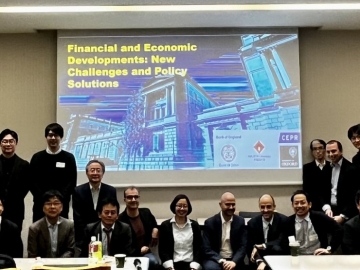Since the conclusion of the strategic partnership for joint research in 2016, both universities are making progress in many fields.
Prior to the upcoming event “University of Birmingham Day at Waseda University” which will be held during 26th to 27th November 2018, Professor Ryuichi Kodama (Faculty of Letters, Arts and Sciences) has participated to the “Shakespeare Institute, University of Birmingham, Thursday Seminar” last fall. Please refer to the report below.
Global Japanese Studies Model Unit Joint Event
“Shakespeare Institute, University of Birmingham, Thursday Seminar”
 Of the major global Shakespeare research facilities, the Shakespeare Institute, organized under the University of Birmingham in the UK, is the one that is headquartered in Shakespeare’s home town of Stratford-upon-Avon. Some of the foremost personages in the field are affiliated with the Institute as its faculty (researchers), and the Institute is focused on fostering post-graduate researchers from the master’s level to the doctorate level and beyond. As part of the curriculum for students attending the Institute, attendance at seminars conducted every Thursday is recommended. With the exception of the first time the seminar was held, these events, which are open to members of the general public and graduates living nearby, or to anyone else interested, have been conducted with outside lecturers invited to participate. On October 5 (the second time during the 2017–2018 academic year), Waseda University’s Professor Ryuichi Kodama was invited, and thus a joint seminar was conducted in Stratford-upon-Avon by the Shakespeare Institute and Waseda University’s Global Japanese Studies Model Unit. Because the subject of the seminar was Yukio Ninagawa, who passed away the previous year, Hiroko Yamaguchi, a reporter for the Asahi Shimbun who was close friends with the departed director, was also there to speak.
Of the major global Shakespeare research facilities, the Shakespeare Institute, organized under the University of Birmingham in the UK, is the one that is headquartered in Shakespeare’s home town of Stratford-upon-Avon. Some of the foremost personages in the field are affiliated with the Institute as its faculty (researchers), and the Institute is focused on fostering post-graduate researchers from the master’s level to the doctorate level and beyond. As part of the curriculum for students attending the Institute, attendance at seminars conducted every Thursday is recommended. With the exception of the first time the seminar was held, these events, which are open to members of the general public and graduates living nearby, or to anyone else interested, have been conducted with outside lecturers invited to participate. On October 5 (the second time during the 2017–2018 academic year), Waseda University’s Professor Ryuichi Kodama was invited, and thus a joint seminar was conducted in Stratford-upon-Avon by the Shakespeare Institute and Waseda University’s Global Japanese Studies Model Unit. Because the subject of the seminar was Yukio Ninagawa, who passed away the previous year, Hiroko Yamaguchi, a reporter for the Asahi Shimbun who was close friends with the departed director, was also there to speak.

Professor Ryuichi Kodama
Professor Ryuichi Kodama is affiliated with Waseda University’s Faculty of Letters, Arts and sciences and currently serves as the associate director of the Tsubouchi Memorial Theatre Museum. He has extensive knowledge in his research areas of Japanese classical theater—with emphases on kabuki and joruri in kabuki—and Japanese modern performing arts in the 19th and 20th centuries; he is also engages in theatrical criticism. After Hiroko Yamaguchi joined the Asahi Shimbun, she was assigned to cover and critique the theater; she also has experience as a visiting researcher at the Waseda Theatre Museum (now the Tsubouchi Memorial Theatre Museum). The extent of her interactions with Yukio Ninagawa can be seen in her conducting interviews for, composing, and writing the book Ninagawa Yukio no Shigoto (The Work of Yukio Ninagawa), which was published as part of Shinchosha’s Tonbo-no-Hon series.
The lecture, which was conducted in English, started out with a mention of the Tsubouchi Memorial Theatre Museum, which was founded in 1929. Professor Kodama explained that the reason for the museum’s founding was a celebration of Shoyo Tsubouchi reaching the auspicious age of seventy; it was also in commemoration of the completion of the translation of the complete theatrical works of Shakespeare. Moving onto another subject, Professor Kodama said that the adaptation by Mokuami Kawatake of Edward Bulwer-Lytton’s 1840 play Money into the kabuki work Ningen Banji Kane no Yo no Naka in 1879 demonstrated the degree to which foreign works were gaining acceptance in Japan during that time. The professor noted that the means by which these works were accepted involved retaining the main plots of the stories while changing the characters’ names and the geographical setting. Professor Kodama argued that, unlike the direct translations done later by Shoyo Tsubouchi, this method of adaptation made works more Japanese.
Professor Kodama then noted the uniqueness of Yukio Ninagawa’s productions of Shakespeare plays amid the context of this distinction between translation and adaptation; in particular, he cited NINAGAWA Macbeth (first performed in 1980, followed by reprisals in 1985, in the Netherlands and Scotland also in 1985, in England in 1987, in 1989, in the US and Canada in 1990, in Singapore in 1992, in 1997 through 1998, in 2015, and in 2017). Traditionally, if the historical setting of a play were changed to 16th-century Japan, the names of the characters would also be made Japanese; however, Yukio Ninagawa did not do so, and what the characters called one another was grounded in Shakespeare’s original text. Professor Kodama argued that, looking back at the world of Japanese theater before the 1960s—when actors often aimed to appear white—the approach to staging that Yukio Ninagawa took in 1980 demonstrated how adaptation had changed.
When NINAGAWA Macbeth was first performed in London in 1987, it was praised by critic Michael Billington in The Guardian under the headline, “The rising sun falls on Glamis – Yukio Ninagawa’s breathtaking production of ‘Macbeth’ at the Lyttelton,” suggesting that this was—with a stage that truly seemed to symbolize Japan during its period of rapid economic growth—a work that could find an audience during such an era. Afterward, this version of the play was put on the shelf for some time. The 2015 revival ended up being the last performance during which Yukio Ninagawa was able to participate from the rehearsals through closing night. With this background explained, Professor Kodama noted that, although the memorial performance of the play in London had been somewhat of a success, there had been changes (in terms of economics and lifestyle) to conditions in Japan. In other words, some of the Japanese-style concepts employed in the staging could no longer be called truly reminiscent of Japan. For example, Professor Kodama suggested that it would not be an exaggeration to say that the practice of having in one’s home a Buddhist altar that is thought of as forming a connection to the afterlife when its doors are opened is in the process of disappearing from modern people’s lives, as are other traditional aspects of Japanese culture. Nevertheless, it is precisely this kind of spirit that one would expect would stimulate feelings of nostalgia among people in Japan, making NINAGAWA Macbeth a work that for today’s Japan is both typical and unique; Professor Kodama said that it will be interesting to see how the play is accepted by the Japanese of today—for whom there have been changes in terms of the era, the regions in which most people live, and lifestyle—as well as how it will be regarded in the UK.
The seminar then proceeded in Japanese, along with interpreting. Professor Kodama showed the audience photographs of Ninagawa’s productions, recordings of performances, and other materials while providing commentary.
 Professor Kodama started his commentary with the opening scene of the 1985 debut of NINAGAWA Macbeth, during which the three wayward sisters are played by male actors, including a kabuki onnagata (Tokusaburo Arashi). In this year’s production, the same role is played by Kyozo Nakamura. However, Professor Kodama noted that these choices of actors are, in fact, the only kabuki elements included in NINAGAWA Macbeth. The reason cited for why the audience feels a kabuki atmosphere is that the historical backdrop for the production is the period when kabuki arose, and that fertile soil is part of the staging.
Professor Kodama started his commentary with the opening scene of the 1985 debut of NINAGAWA Macbeth, during which the three wayward sisters are played by male actors, including a kabuki onnagata (Tokusaburo Arashi). In this year’s production, the same role is played by Kyozo Nakamura. However, Professor Kodama noted that these choices of actors are, in fact, the only kabuki elements included in NINAGAWA Macbeth. The reason cited for why the audience feels a kabuki atmosphere is that the historical backdrop for the production is the period when kabuki arose, and that fertile soil is part of the staging.
Next, Professor Kodama presented Ninagawa’s production of Hamlet, presenting its unique staging, in which the form of a hinamatsuri altar was included in the set. He also drew attention to how characters from previous generations were made to speak in older forms of Japanese while those of the current generation were made to speak contemporary Japanese. It would be safe to say that there are extremely few cases of differentiating among characters in a single performance by employing differently translated lines.
As a counterpoint, the professor also brought up an example of a version of Hamlet that was entirely reimagined in kabuki form. In this staging, the protagonist, Hamlet, and the heroine, Ophelia, are played by a single actor (Somegoro Ichikawa), and the roles are switched between in the rapid style particular to kabuki. The father of Somegoro Ichikawa, who acted in this production, was the ninth actor to take the stage name Koshiro Matsumoto; his father had played Othello, just like the two younger actors. Thus, the seminar attendees were shown how there appears to be a family—appearing before audiences a world apart from Stratford-upon-Avon—who have played the part of Othello for three generations. In the world of kabuki, there is a tradition of signature roles being passed down from generation to generation, and it is extremely interesting that this tradition has now been practiced with Shakespeare, as well.
 The next clips shown were from a production of The Merchant of Venice put on by the second generation of actors from the Zenshinza troupe. This production gained attention as an example of a show from the 1990s that used old-fashioned methods of expression, in imitation of a filming of the show’s debut that was held in the collection of Waseda University’s Theatre Museum. In terms of a more recent production, the audience was presented with a reading conducted in Waseda University’s Ono Memorial Hall and were shown a rare example of Kyozo Nakamura, who is currently appearing in NINAGAWA Macbeth as an onnagata (a male actor who plays female roles), performing the male part of Shylock. This helped to represent the breadth of kabuki actors’ performance skills and the breadth of kabuki itself as a form of theater. Many of Japan’s traditional performing arts—not limited to kabuki—are in this way tolerant and flexible, and this is apparent even in the modern day. NINAGAWA Macbeth, whose staging begins with a functional Buddhist altar opening and ends with it closing, represents the cyclicality of all things and is, in some respects, closer to Noh in its concepts than to kabuki. The way in which Noh plays begin and end with the appearance on, and eventual leaving from, the stage of the performers and the orchestra is similar in some ways to the original Shakespearian performance style, and Professor Kodama noted how one unexpectedly comes across seemingly unlikely commonalities between the two.
The next clips shown were from a production of The Merchant of Venice put on by the second generation of actors from the Zenshinza troupe. This production gained attention as an example of a show from the 1990s that used old-fashioned methods of expression, in imitation of a filming of the show’s debut that was held in the collection of Waseda University’s Theatre Museum. In terms of a more recent production, the audience was presented with a reading conducted in Waseda University’s Ono Memorial Hall and were shown a rare example of Kyozo Nakamura, who is currently appearing in NINAGAWA Macbeth as an onnagata (a male actor who plays female roles), performing the male part of Shylock. This helped to represent the breadth of kabuki actors’ performance skills and the breadth of kabuki itself as a form of theater. Many of Japan’s traditional performing arts—not limited to kabuki—are in this way tolerant and flexible, and this is apparent even in the modern day. NINAGAWA Macbeth, whose staging begins with a functional Buddhist altar opening and ends with it closing, represents the cyclicality of all things and is, in some respects, closer to Noh in its concepts than to kabuki. The way in which Noh plays begin and end with the appearance on, and eventual leaving from, the stage of the performers and the orchestra is similar in some ways to the original Shakespearian performance style, and Professor Kodama noted how one unexpectedly comes across seemingly unlikely commonalities between the two.
In conclusion, the professor appealed to those in attendance at the venue to show even greater interest in Japanese adaptations of Shakespeare while referring to the perspectives presented above.
Ms. Yamaguchi’s interactions with Yukio Ninagawa as a reporter on the theater beat went on for around 30 years. During her lecture, she focused on Yukio Ninagawa as a person and the theatricality of his works. First, she demonstrated Mr. Ninagawa’s forthright attitude that did not attempt to hide the circumstances he faced by showing the cover photograph of one of her books, which depicted the man as he battled his illness.
Mr. Ninagawa is known for being extremely prolific, but in the lecture, Ms. Yamaguchi developed her thesis by concentrating on three aspects of the man: Everything in the lecture could be classified as pertaining to Mr. Ninagawa’s activities as the most famous theater director in Japan, his activities as artistic director at both the publicly funded Sainokuni Saitama Arts Theater and the commercially operated Bunkamura Theatre Cocoon, and his running of two troupes at the Sainokuni Saitama Arts Theater. Mr. Ninagawa, who aspired to become a painter when he was young, joined the Seihan troupe as an actor after failing the entrance examination at Tokyo University of the Arts. Mr. Ninagawa felt out-of-step with the direction in which the troupe was headed and founded the troupe Gendaijin Gekijo in 1967. In 1969, he staged Such a Serious Frivolity, marking his debut as a full-fledged director. An unusual feature of this work is that a stairway is installed on the stage. The work is staged such that the older performers stand next to one another in an orderly fashion, while the younger actors jeer at each of them from the top of the staircase. The development of the plot, in which the young people given latitude in the first half of the play are, in the latter half, restrained and eventually killed, symbolized, among other things, the student movements of the day. In other words, what happened within the theater reflected events occurring outside the theater. The lights dim at the end of the performance, and when they come back on, the actors, now dressed as policemen, surround the theater, and the rioting and chaos of the real world is symbolically instigated by the audience in the theater. This style of connecting the world outside the theater to the performance within it and stimulating and drawing in the audience is the very core of Ninagawa theater and is vital to understanding his approach and methods.
 As Japan’s political situation calmed down, Mr. Ninagawa’s staging also changed, and thus the topic of Ms. Yamaguchi’s lecture switched to the director’s production of Romeo and Juliet during this period. Because Mr. Ninagawa was hired by a leading commercial troupe for this production, he came to be seen in a critical light by his old friends in his own troupe, leading to its disbandment. This work, in which the ninth-generation Koshiro Matsumoto played Romeo, did not include any Japanese elements, but it did incorporate elements of the Shakespeare plays that Mr. Ninagawa was already contemplating. Here, too, a stairway is used as a device on the stage; the high-status characters are placed on the upper steps, with poor characters relegated to the lower steps. The play is staged so that the love of the two youths is performed before a group of nameless citizens. This staging reflects Mr. Ninagawa’s interpretation that love like that experienced by Romeo and Juliet cannot happen to anyone but is only visited on a few chosen people, thus making the play a mythic story.
As Japan’s political situation calmed down, Mr. Ninagawa’s staging also changed, and thus the topic of Ms. Yamaguchi’s lecture switched to the director’s production of Romeo and Juliet during this period. Because Mr. Ninagawa was hired by a leading commercial troupe for this production, he came to be seen in a critical light by his old friends in his own troupe, leading to its disbandment. This work, in which the ninth-generation Koshiro Matsumoto played Romeo, did not include any Japanese elements, but it did incorporate elements of the Shakespeare plays that Mr. Ninagawa was already contemplating. Here, too, a stairway is used as a device on the stage; the high-status characters are placed on the upper steps, with poor characters relegated to the lower steps. The play is staged so that the love of the two youths is performed before a group of nameless citizens. This staging reflects Mr. Ninagawa’s interpretation that love like that experienced by Romeo and Juliet cannot happen to anyone but is only visited on a few chosen people, thus making the play a mythic story.
For typical productions of Shakespeare plays in the Japan of those days, one imagined cultured people viewing the drama in solemn silence. However, Mr. Ninagawa focused on the more fun aspects of the story, and he aimed to depict the play’s characters in a more dynamic light. Because this undertaking was something different from the staging typical of large commercial theaters, it was met with mixed reviews. Nevertheless, Mr. Ninagawa received massive support from audiences and went on to direct a long succession of staged works. During the 1980s, Mr. Ninagawa did not confine himself to staging plays in Japan, setting forth overseas to bring his productions to new audiences and laying the groundwork for future endeavors.
Mr. Ninagawa strove to stage Shakespeare’s plays not as difficult classics from England but in a way that could persuade Japanese audiences to enjoy them, and he considered it vital to highlight the plays’ visual beauty and the entertainment value of their plots. NINAGAWA Macbeth is a work representative of this approach. At the Sainokuni Saitama Theater, there was a project to perform the complete works of Shakespeare. The project was canceled after only 32 works were performed, but some of those included productions with all-male casts. Here, Mr. Ninagawa was respectful to represent the complex and bawdy aspects of the performing arts. This approach was underpinned by the fundamental principle of always allowing the audience enjoy themselves. There were eccentricities in the casting of Cymbeline, which was performed in both Japan and London in 2012. However, that did not mean that the play had been rendered excessively Japanese. Still, in the aftermath of the 2011 Great East Japan Earthquake, some argued that the people of Japan were calling for the family to be reunited at the conclusion of the story, and Mr. Ninagawa incorporated this plot development into his production. In other words—which can be said about all the staged works that Mr. Ninagawa directed—there was a question of how to connect British classics to modern Japan, and how this question was answered attracted the interest of audiences overseas.
A peculiarity of Mr. Ninagawa’s productions was how he treated the choruses in Greek tragedies as the populaces of the plays’ settings; the texts of the plays and their direction seemed to be combined organically. In a 2012 production of The Trojan Women staged in commemoration of 60 years of diplomatic relations between Japan and Israel, Mr. Ninagawa made sure to include Arabs in the cast composed of Japanese and Israeli nationals. By adding Arabs—who are a minority group in Israel—to the production in the spirit of equality, the casting suggested that all, regardless of whether they were part of the majority or the minority, could pool their efforts in service of their homeland. This also provided a glimpse into what it was like for Mr. Ninagawa to be a person from Asia directing European theater.
In Mr. Ninagawa’s later years, he put much of his efforts into a troupe, called the Golden Theater, whose membership was limited to the elderly and that was based in the Sainokuni Saitama Theater. A feature of this troupe was that its members were not merely older actors but rather people without previous experience performing in plays. A reason given for this decision was that, by adding to dramatic performances the accumulated experiences of people who had lived long lives as members of the general public, Mr. Ninagawa was attempting to create something new on the stage. In parallel, Mr. Ninagawa ran a troupe called the Next Theater whose membership was limited to actors in their twenties. At times, this troupe collaborated with the Golden Theater to perform productions. One of these collaborations that gained particular attention was a 2015 run of Richard II, into which Mr. Ninagawa incorporated the wide range of Shakespearian theatrical techniques that he had developed. In particular, the ideal that “three minutes after the curtain rises, the audience must be shepherded to a world somewhere far away” was strongly evident. In this production, Mr. Ninagawa cast many actors in wheelchairs—as the director himself was then using one at that time—and presented the story of English royalty reimagined as happening among an elderly family in Japan. Ms. Yamaguchi concluded her lecture by stating that she would be heartened if her presentation of Mr. Ninagawa’s staging style from his early years through the last years of his life had, in some small part, conveyed what made the director’s productions unique and what was hidden beneath the surface.
After the two lectures, there was a lively question and answer session. People continued to exchange views in the pleasant atmosphere of the tea break that always follows lectures at the Shakespeare Institute. The various activities planned for the event thus concluded successfully.
Note:
Professor Ryuichi Kodama (Simultaneous interpreting: Assistant Professor Yu Umemiya of the Faculty of Letters, Arts, and Sciences)
Hiroko Yamaguchi (Simultaneous interpreting: Professor Tetsuhito Motoyama of the Faculty of Law / Rosalind Fielding, PhD candidate, The Shakespeare Institute)








